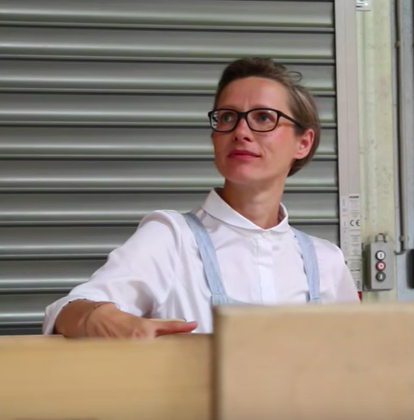Sie sehen gerade einen Platzhalterinhalt von Youtube. Um auf den eigentlichen Inhalt zuzugreifen, klicken Sie auf die Schaltfläche unten. Bitte beachten Sie, dass dabei Daten an Drittanbieter weitergegeben werden.
Besides the names of the artists on show, the visitors of an exhibition also know the name of the curator. What most visitor’s don’t know, is that behind every exhibition stands a big team that prepares the exhibition. This includes exhibition managers, registrars, and collection managers. On the occasion of the ERC – European Registrars Conference – that takes place in Vienna for the first time from June 8th through June 10th, 2016, we have interviewed Andrea Hofinger – Loan Registrar of the TBA21, Thyssen-Bornemisza Art Contemporary. In an interview with Sabrina Möller, and Valentina Marterer, she speaks about her profession’s complexities.
You belong to the ARC’s – the Austrian Registrars Committee’s founding members. With what motivation did you and your colleagues found the committee?
Most of us already stood in a professional relationship. The idea to found a committee became concrete when we got together at the European Registrars Conference in Edinburgh in 2012. We asked ourselves why we – collection managers, registrars and exhibition managers in Austria – hadn’t gotten together to pursue our common interests. Back then, similar committees already existed in other countries. We quickly decided to change this and to found a committee ourselves. Our first talks intended to define what a registrar is. We had quickly noticed that our professional day by day includes many overlapping responsibilities. Also, tasks vary from one institution to the next.
How would you define the profession of the registrar?
A registrar has to handle a vast range of different task. Either you organize exhibitions as an exhibition manager, or you work as a registrar and primarily take care of collections and museum loans, as well as the contracts, insurance formalities, transportation and storage issues, documentation, inventories, and data bases, that come with it. A registrar is also a archiver. The conservation of all collection pieces is one of his or her main responsibilities.
What are the ARC – Austrian Registrars Committee’s long term goals?
Networking is our first priority. We’re looking for exchange, and hoping to overcome difficulties together. In the long run, we’re aiming to set lasting standards for our profession.
Professional training and higher education are also high on the list. Most of us are self-taught. In Austria, there’s no training program for registrars in this field. The committee allows us to share experiences, to pass on information, and to teach each other. We’ve already put on conferences on different subjects, such as condition reporting, transportation and insurance. Among other things, we’ve given a presentation about the profession and our field of activities at the University of Vienna. The students were very interested. They study a lot of theory, but are taught very little practical knowledge.
Visibility is therefore a very important task for the ARC. This is our only way to pass on what’s happening behind the scenes, and to show how registrars work. We work behind the scenes, not on the stage. When a visitor enters an exhibition, he won’t get to see a registrar. It’s one of our concerns to make these activities transparent, to bring them „out of the box“ .
You were already working at the TBA21 (Thyssen-Bornemisza Art Contemporary), when you and your colleagues founded the committee. In how far has the committee so far helped you in your professional everyday life?
It has become easier to collaborate with colleagues from different institutions. Different work sequences become easier when you know each other on a personal basis. It also reduces the bureaucracy.
In the context of the exchanges and conferences on related subjects which we organize on a regular basis for members we also continuously learn ourselves. In the ERC’s – European Registrars Conference – agenda, the standardization of procedures is a recurring theme.
Every country has its own legal status which reflects on contracts- such as loan contracts-. A standardization of contracts and procedures would reduce costs. When it comes to museum loans, institutions usually charge each other, which implies a lot of bureaucracy. There’re always charges on both sides. If we could do without them, we might not reduce the overall costs very much, but we could definitely reduce the work effort.
The main focus of your activities at the TBA21 are loans. Why did this area capture your interest? It does sound like a lot of bureaucracy.
Of course I have to deal with a lot of bureaucracy, but handling loans is a bit like the organization of an exhibition: every loaned piece is a little project. You need to take just as many factors into account as you do for a whole exhibition. The works’ condition needs to be taken care of, and also the packaging and transport. High-quality photographic material and background information need to be provided, the installation and deinstallation have to be done correctly. We also need to ensure that all pieces are titled correctly, both in the catalogue, and in the show. It’s a rewarding experience to see the works staged in the show. Every procedure and every loan bring some sort of novelty. Even more so because in the TBA21 we have contemporary and therefore very complex works that exceed classic oil paintings by far and therefore demand much more work.
How so?
Many of our works are installations that don’t belong to any of the classic categories – painting, photography, sculpture, architecture, or film. Instead, they were developed in some sort of an in-between. We need an individually drafted Installation Manual for almost every work. Whenever possible, we witness the installation ourselves, or else send a technician or some sort of a handler. He installs the work following the installation manual, which works like a set of instructions.
The registrar’s work and his/her challenges vary depending on the collection and the type of works. While some registrars specialize on antique works of art of great value, others dedicate themselves to complex contemporary installations that can be of just as much value.
What are the fundamental differences between an exhibition manager and a registrar?
As a matter of fact, one and the same person can exercise both functions. This depends on the individual institution and its size. An exhibition manager is responsible for having the show installed on time and in the right position, according to the artist’s or the curator’s wishes. Collection managers and/or registrars are primarily in charge of the collection and are also very much involved with the work’s documentation as well as collection strategies.
The aftermath of an exhibition is also an important task for the registrar: have there been changes? Has the work’s condition been altered? Is a restoration needed?
How closely do you collaborate with restorers?
It’s our responsibility to regularly check the collection and the works’ condition. Depending on the works’ condition, we then get in touch with the restorers. This is of paramount importance to us because many works need regular supervision and controls. Plasticine or latex, for instance, are materials that can change over time. This is the thrill of contemporary art: it is close to current materials that have not, or have only very scarcely been studied by restorers. In this aspect, the TBA21 stands in close collaboration with the academy and the department for restoration. It proposes questions and problematics specific to individual works as subjects for thesis research in order to recruit students to do the corresponding research. This is how we investigate how to limit certain phenomenons, or how to preserve works.
When a restoration becomes necessary: in how far are the artists involved?
The collaboration with the artists is essential because they know their works best. Because TBA21 commissions many works, we quite often get to accompany the entire production process of a work of art. For the security of both sides, we have agreements with the artists. Transparency is extremely important. This includes information regarding the materials, in how far they might change, and how to deal with such eventualities. If a work might dissolve over time, this needs to be discussed. In Mario García Torres’ collection, we have such a case: it includes faxes that are going to dissolve over time. This is fine with us, because we made an agreement with the artist on how to proceed once this occurs.
How did you find your profession? How does one become a registrar?
I used to work as a curator and soon discovered that I’d rather organize than present a show. A registrar has to have a love for details, structure, and project management. Everyone who wants to be really close to art would probably rather be a registrar than a curator. Because as a registrar, you know the works by heart. The fronts, the backs, the frames, all technical details and possible defects.
What are your everyday challenges?
There is no such a thing as a daily routine. Every day is different. There are, however, certain steps, that keep on repeating. Among them is the handling of loan contracts. There’re always unpredictable challenges: i.e. to get a work that has been requested last minute for an exhibition. Or a work that has been acquired but has arrived in a condition different from what had been agreed. Or a work arrives already damaged at the exhibition, or in the collection, because it has been handled wrong during transportation, or by the sender himself. The challenges are varied, and this is precisely why this field is so interesting.

